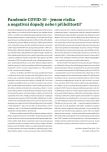Pulmonary alveolar proteinosis: repeated bilateral whole lung lavage supported by extracorporeal membrane oxygenation
Authors:
J. Beneš 1; P. Roleček 1; V.- Černý 1 5
Authors‘ workplace:
Klinika anesteziologie, perioperační a intenzivní medicíny, Univerzita J. E. Purkyně v Ústí nad Labem, Masarykova nemocnice v Ústí nad Labem
1; Institut postgraduálního vzdělávání ve zdravotnictví, Praha
2; Centrum pro výzkum a vývoj, Fakultní nemocnice Hradec Králové
3; Dept. of Anesthesia, Pain Management and Perioperative Medicine, Dalhousie University, Halifax, Canada
4; Klinika anesteziologie, resuscitace a intenzivní medicíny, Univerzita Karlova v Praze, Lékařská fakulta v Hradci Králové
5
Published in:
Anest. intenziv. Med., 31, 2020, č. 1-2, s. 42-45
Category:
Case Reports
Overview
Whole lung lavage with large quantity of normal saline is the current standard of care treatment of pulmonary alveolar proteinosis. This rare disease characterized by alveolar accumulation of lipoproteinaceous material leads to respiratory failure of different severity. In some cases, it is not possible to perform the treatment safely without risk of severe periprocedural hypoxia. These rare cases can be treated with the support of extracorporeal membrane oxygenation. We present a case of a 41-year old patient successfully treated with repeated bilateral whole lung lavage supported by extracorporeal membrane oxygenation. Extracorporeal membrane oxygenation has been used during whole lung lavage in patients with risk of life-threatening hypoxia. The increasing availability and safety of extracorporeal life support methods enables more frequent use of the methods in cases with significant risk of hypoxia related complications that have so far been treated with one lung ventilation. This practice increases not only safety but also effectivity of the procedure because it enables performance of bilateral lavage in one session.
Keywords:
pulmonary alveolar proteinosis – whole lung lavage – extracorporeal membrane oxygenation
Sources
1. Seymour JF, Presneill JJ. Pulmonary Alveolar Proteinosis. Am J Respir Crit Care Med. 2002; 166: 215–235. doi:10.1164/rccm.2109105.
2. Campo I, Luisetti M, Griese M, Trapnell BC, Bonella F, Grutters J, et al. Whole lung lavage therapy for pulmonary alveolar proteinosis: a global survey of current practices and procedures. Orphanet J Rare, DiS. 2016; 11: 115. doi:10.1186/s13023-016-0497-9.
3. Ohashi K, Sato A, Takada T, Arai T, Nei T, Kasahara Y, et al. Direct evidence that GM‑CSF inhalation improves lung clearance in pulmonary alveolar proteinosis. Respir Med. 2012; 106: 284–293. doi:10.1016/j.rmed.2011. 10. 019.
4. Greenhill SR, Kotton DN. Pulmonary alveolar proteinosis: a bench‑to‑bedside story of granulocyte‑macrophage colony‑stimulating factor dysfunction. Chest. 2009; 136: 571– 577. doi:10.1378/chest.08-2943.
5. Vymazal T, Krecmerova M. Respiratory Strategies and Airway Management in Pati‑ ents with Pulmonary Alveolar Proteinosis: A Review. Biomed Res Int. 2015; 2015: 1–5. doi:10.1155/2015/639543.
6. Zapol WM, Wilson R, Hales C, Fish D, Castorena G, Hilgenberg A, et al. Venovenous bypass with a membrane lung to support bilateral lung lavage. JAMA. 1984; 251: 3269–3271. doi:10.1001/jama.1984.03340480051028.
7. Krecmerova M, Mosna F, Bicek V, Petrik F, Grandcourtova A, Lekes M, et al. Extracorporeal membrane oxygenation to support repeated whole‑lung lavage in a patient with pulmonary alveolar proteinosis in life threatening dyspnoe – a case report. BMC Anesthesiol. 2015; 15: 173. doi:10.1186/s12871-015-0152-3.
Labels
Anaesthesiology, Resuscitation and Inten Intensive Care MedicineArticle was published in
Anaesthesiology and Intensive Care Medicine

2020 Issue 1-2
Most read in this issue
- Sedation in the intensive care unit – part I.
- Airway management in the adult prehospital medicine – to tube or not to tube?
- Perioperační péče o pacientky podstupující císařský řez
- Obecné zásady péče o pacienta s COVID-19 na pracovišti intenzivní péče
